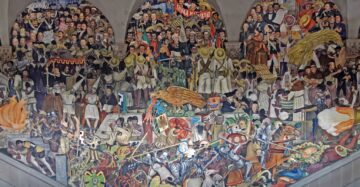Nicolas Medina Mora in The Millions:
 The region, we’re told, extends from the deserts of Sonora to the straits of Tierra del Fuego, encompassing 7.7 million square miles that are home to 660 million people who share two Latinate languages: Spanish and Portuguese. What complicates the picture is that many in that vast expanse also speak Nahuatl, Quechua, and hundreds of other tongues. But it’s not just the language: the people of this region, we hear, are Catholic. Even if we set aside the fact that many of them are Pentecostal or Jewish, however, the Catholic traditions of Oaxaca would be unrecognizable to churchgoers from Rio de Janeiro. This inconvenient diversity perhaps explains why, when all else fails, we’re told that all of these people love to dance.
The region, we’re told, extends from the deserts of Sonora to the straits of Tierra del Fuego, encompassing 7.7 million square miles that are home to 660 million people who share two Latinate languages: Spanish and Portuguese. What complicates the picture is that many in that vast expanse also speak Nahuatl, Quechua, and hundreds of other tongues. But it’s not just the language: the people of this region, we hear, are Catholic. Even if we set aside the fact that many of them are Pentecostal or Jewish, however, the Catholic traditions of Oaxaca would be unrecognizable to churchgoers from Rio de Janeiro. This inconvenient diversity perhaps explains why, when all else fails, we’re told that all of these people love to dance.
Still, isn’t it true that these people share a history of resistance to empire and colonialism? Perhaps. But it’s just as true that all of these countries continue to inflict colonial violence on Indigenous people and that their economic elites are composed almost exclusively of people who could accurately be described as white. Besides, long before the name of the region became a synonym for resistance against Yankee imperialism, the term was popularized by nineteenth-century Frenchmen who, finding it difficult to justify their imperial designs in a part of the world to which they had no connection, were forced to reach back to Ancient Rome and cast themselves as the champions of the “Latin race.”
More here.
